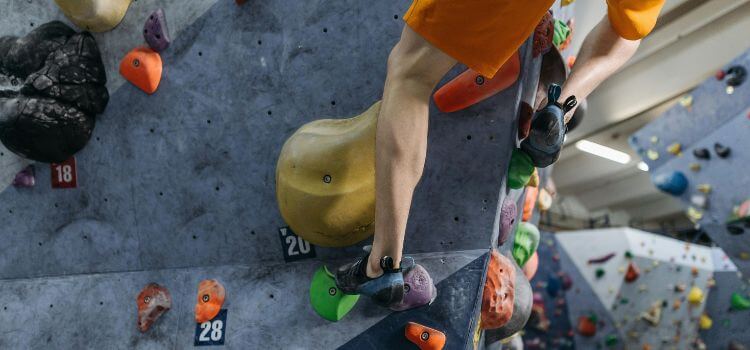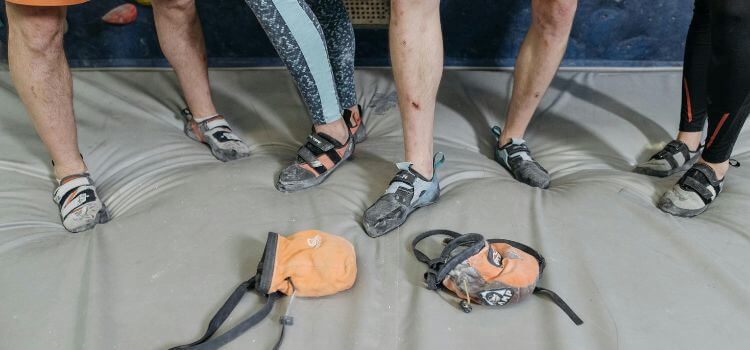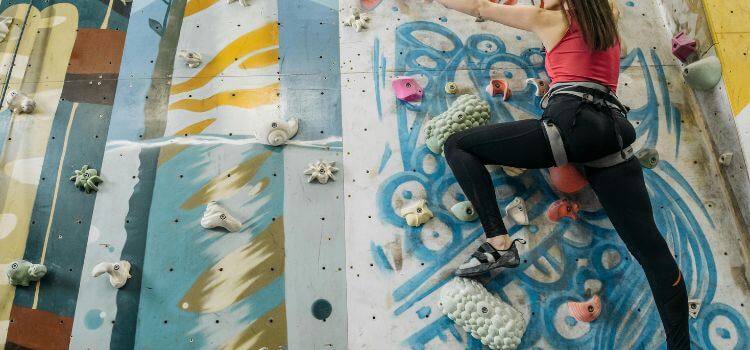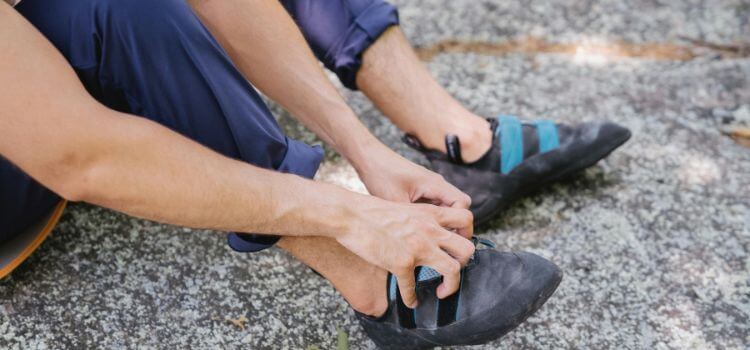As an Amazon Associate I earn from qualifying purchases.
Replace your climbing shoes when they show significant wear, like holes in the toe or a worn-down sole. Opt for new shoes if your current pair loses shape or performance.
Climbing shoes are critical for your safety and performance on the rock. As you link to the wall, they must maintain their integrity and grip. Experienced climbers know that the right time to invest in a new pair can make the difference between struggling on a route and effortlessly reaching the top.

While beginners might wear their shoes slower than seasoned veterans, they, too, should pay attention to the signs of wear and tear. Your shoes’ lifespan depends on various factors, including climbing frequency, surface type, and the shoe’s material and construction. Recognizing these signs early ensures you stay safe and continue to enjoy climbing without unnecessary setbacks due to equipment failure.
Signs Of Worn-out Climbing Shoes
Climbing shoes are vital for a safe and effective climb. It is crucial to recognize when they need replacement. Look for these signs to ensure your gear is in top shape.
Worn Down Soles
Thin or smooth soles reduce grip, and uneven wear can also affect performance. Check if the sole’s pattern is barely visible or if you see holes near the toe area.
Toe Rubber Damage
- Visible toe damage indicates it’s time for new shoes.
- Look for holes or severe thinning on the rubber over the toes.
Stretching And Shape Loss
Leather climbing shoes stretch over time. If your shoes feel looser than before, they may have lost shape, which can affect performance. Ensure the shape matches your foot’s contours.
The Impact Of Climbing Style
The Impact of Climbing Style on the lifespan of your climbing shoes cannot be overstated. Different styles of climbing can lead to varying degrees of wear and tear. Understanding this can help climbers make informed decisions about when to replace their trusty footwear. Let’s explore how bouldering and long-route climbing, as well as climb intensity and frequency, affect shoe longevity.

Bouldering Versus Long Routes
Bouldering often subjects shoes to intense pressure during short, powerful moves, which can accelerate wear in specific areas like the toe box. Conversely, long-route climbing, which includes multi-pitch and traditional routes, spreads the pressure across the shoe over longer periods. Climbers tackling these routes might notice a more uniform wear pattern.
- Bouldering may require more frequent replacements due to aggressive movements.
- Long-route climbing can lead to slower but broader wear.
Intensity And Frequency Of Climbs
The frequency and intensity of your climbs play crucial roles in determining shoe life. Climbing at a high intensity on rough surfaces can wear out shoes quickly. Additionally, climbing more than three times a week can accelerate the breakdown of materials and adhesives in your shoes.
| Intensity | Frequency | Expected Shoe Life |
| High | Daily | Quicker Replacement |
| Moderate | Weekly | Longer Durability |
| Low | Monthly | Extended Life Span |
Keep tabs on the sole thinness, edge integrity, and rubber condition. These indicators will signal when to replace your climbing shoes based on your climbing style and habits.
Shoe Material And Longevity
Shoe Material and Longevity play pivotal roles in determining the lifespan of your climbing shoes. Understanding these key factors is key to identifying the right time for a replacement. As you delve into the world of climbing shoes, assessing their material and build quality will guide you in making the perfect choice for both comfort and durability.
Leather Vs. Synthetic
Leather and synthetic materials define the stretch and breathability of climbing shoes. Here’s what climbers need to know:
- Leather shoes adjust to your feet over time, providing a custom fit. They tend to stretch more and offer natural breathability.
- Synthetic shoes maintain their shape better and are a consistent choice for vegan climbers. However, they often have less stretch and might be less breathable.
Quality Of Construction
The build quality directly influences how long your shoes last. High-quality construction means more climbs and better performance. Key factors include:
| Construction Feature | Impact on Longevity |
| Stitching | Precise stitching prevents early wear. |
| Glue Quality | Strong adhesives keep shoes intact longer. |
| Material Overlay | Layering adds durability to high-stress areas. |
| Rubber Thickness | Thicker rubber can enhance lifespan but may reduce sensitivity. |
Regular Maintenance
Love for climbing demands care for your gear. Regular maintenance extends the lifespan of your climbing shoes. Let’s explore preserving the grip and fit of your trusty partners.
Cleaning Techniques
Cleaning Techniques
Keep your shoes in top shape with simple cleaning steps. Dirt and grime reduce performance, and a clean pair means better climbing.
- Wipe off excess dirt with a brush.
- Use mild soap and lukewarm water for a deep clean.
- Gentle scrubbing works away stubborn marks.
- Avoid harsh chemicals that might degrade the rubber.
Proper Drying And Storage
Moisture can damage climbing shoes. Dry and store them right to avoid problems.
- Pat them dry with a towel.
- Air-dry away from direct sunlight.
- Stuff them with newspaper to absorb moisture.
- Please keep them in a cool, dry place.
Resoling Possibilities
Worn-out soles aren’t the end. Resoling gives shoes a second life. Check for resoling signs, like smooth spots or holes.
| Sign | Action |
| Thin soles | Time for resoling |
| Delaminating rubber | Contact resoling professionals |
| Edge wear | Resole for renewed grip |
Performance And Safety Considerations
Climbing shoes form the foundation of a climber’s grip and stability. Proper gear ensures peak performance and safety. Recognizing when to replace climbing shoes becomes essential. Signs of wear could impact your riding experience. Let’s delve into vital aspects that signal a need for new shoes: grip and precision loss, plus support and protection.

Grip And Precision Loss
The grip is crucial during climbs. Worn-out soles lead to slips.
- Smooth rubber surfaces mean less friction.
- Decreased edging power lessens control on tiny holds.
- You might feel the rock more, but it’s not safe.
Watch for flattened patterns on the sole. It’s time for a change.
Support And Protection
Deteriorating shoes compromise foot support. This can lead to injury. Weak structures in shoes offer less protection. Here’s what to notice:
- Stretched-out uppers mean a sloppy fit.
- Look for tears or holes in the material.
- Damaged toe rand or heel cups reduce protection.
Assess your shoes regularly. Replace them before support fades.
Financial Cost Vs. Climbing Goals
Knowing when to replace climbing shoes is key. The decision often pits financial costs against climbing goals. Brand-new shoes can be pricey. But, achieving higher climbing goals could mean that investment is necessary.
Budgeting For Replacements
Climbing shoes need regular replacement. Factors like frequency of climbs, shoe material, and wall types affect this. Plan for periodic shoe renewal within your annual budget.
- Track shoe wear: Note when shoes start to wear down.
- Save monthly: Set aside a small amount each month.
- Watch for deals: Keep an eye on sales or discounts to save money.
Investing In Higher-end Models
Advanced climbers often pursue better shoes. These shoes support tougher climbs. Quality shoes can be costly but are a long-term investment.
| Shoe Type | Cost | Durability | Performance |
| Entry-Level | Lower | Less | Basic |
| High-End | Higher | More | Advanced |
A strong investment in high-end models can enhance the climbing experience. High-quality shoes last longer, saving money over time. They also offer better grip and comfort for challenging routes.
The Resole Option
The Resole Option becomes a beacon of hope for climbers. It breathes new life into worn-out shoes. By choosing to resolve, climbers save money, extend their shoes’ lifespan, and hold onto that perfect fit they’ve broken in over countless adventures.
When To Resole Instead Of Replace
Understanding the right time to resolve is crucial. Consider resolving when:
- The toe rubber begins to thin but hasn’t worn through.
- Edges start to round off, but the shape remains intact.
- Soles appear smooth, but the rand remains unaffected.
Benefits Of Resoling
Resoling climbing shoes offer distinct advantages:
| Benefit | Description |
| Cost Efficiency | Resoling costs less than buying new shoes. |
| Sustainability | Less waste goes to landfills, helping our planet. |
| Comfort | Keep the fit you love. |
| Performance | Restored grip and precision. |
Making The Decision
Replacing climbing shoes can be tricky. It’s a balance between comfort and holding onto stocks that grip and edge like a dream. The right time for a new pair hovers around noticeable wear and dipping performance. Let’s anchor into the signs that signal a time for change and the shifts in performance versus comfort.
Personal Comfort Vs. Performance Trade-offs
Climbing shoes need to be snug for optimal performance but not so tight they cause pain. Over time, they stretch and mold to your feet. Here, we break down the need for balance:
- Stretched Out: More room means less precision.
- Foot Pain: Pain suggests shoes are too tight.
- Worn Down: Soles thinning reduces grip and safety.
Consider replacing when shoes feel less secure on tiny holds or you’re sacrificing comfort for performance gains. These signs mean it’s time to weigh your priorities.
Recognizing The Right Time To Switch
Knowing when to swap your climbing shoes is critical for performance and safety. Look out for:
Sole Wear Thin spots or holes
Rand Damage Separation or visible wear
Shape Loss Shoes have flattened or stretched
Smell Odor increases despite cleaning
A combination of visual checks, sensory feedback, and performance issues are clear indicators. If multiple boxes are ticked, it’s likely time for a new pair.
Lifecycle Of Climbing Shoes
Understanding the lifecycle of climbing shoes helps climbers determine replacement times. Shoes endure stress from friction, pressure, and outdoor elements. The rubber wears thin, the shape changes and flexibility alters over time. Recognizing these changes is crucial for both safety and performance. Let’s delve into the typical duration you can expect from a pair and tips for extending their life.

Typical Durability Timeframe
Climbing shoes have a varied lifespan based on factors such as frequency of use, climbing style, and material quality. Generally, active climbers might see their shoes last
- 6 to 12 months with regular usage.
- Less frequent climbers might get 1 to 2 years out of a pair.
It’s important to note that your mileage may vary, and some high-performance shoes may wear out faster due to softer rubber compounds designed for better grip.
How To Extend Shoe Life
To extend the life of your climbing shoes, consider the following tips:
- Avoid walking in your shoes on rough surfaces.
- Clean them regularly with a soft brush and water.
- Rotate between multiple pairs if you climb often.
- Be mindful of how you store your shoes, keeping them dry and away from direct sunlight.
Regular maintenance like resoling can breathe new life into your climbing shoes. Choosing to resolve when the rubber begins to thin but before holes develop can save your shoe’s structure and retain its original performance characteristics.
Frequently Asked Questions For When To Replace Climbing Shoes
Replace climbing shoes if they show extreme wear, holes in the toe, or compromised soles. An uncomfortable fit or insufficient grip are signs that it’s time for new shoes. Regular climbers may need replacements yearly.
Climbing shoes can only be resolved when the rand, the rubber around the toe box, is punctured or if the rubber sole is worn through to the inner layer. For best results, resole them before reaching this point.
Resole climbing shoes when you notice thinning soles, visible wear spots, or if the rand (rubber toe cap) starts to develop holes. Regular climbers should inspect their shoes often for these signs to maintain optimal performance.
Conclusion
Deciding on the right moment to replace climbing shoes is crucial for safety and performance. Keen observation of wear patterns and comfort levels will guide you. Trust your instincts—if the shoes don’t feel secure, it’s time for a new pair.
Climb on with confidence, knowing your gear is up to the challenge.
Amazon and the Amazon logo are trademarks of Amazon.com, Inc, or its affiliates.